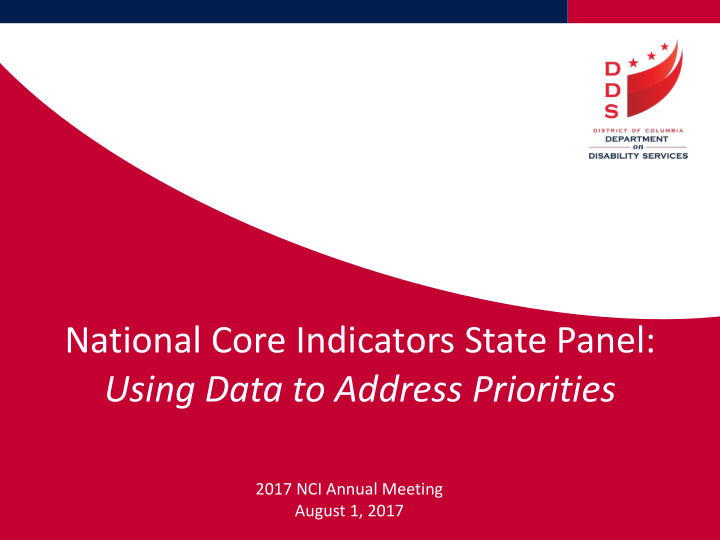



National Core Indicators State Panel: Using Data to Address Priorities 2017 NCI Annual Meeting August 1, 2017
District of Columbia Adult-In Person Adult Family Staff Stability Survey Survey Survey • 2009-2010 • 2009-2010 • 2014 (Base Year) • 2013-2014 • 2013-2014 • 2015 • 2014-2015 • 2014-2015 • 2016 • 2015-2016 • 2015-2016 2
“ Statewide” Uses of NCI Data • Person-Centered Thinking systems change • Supporting Families Community of Practice initiatives • Employment First: SELN; Partners in Employment • HCBS Transition Plan 3
Agency Specific Uses of NCI Data • Person Centered • District-Wide Thinking/Person Performance Centered Reporting Activities Organization Outcomes Program Respectful and Accountability Individualized and Performance Care Programs Management DDS Quality Assurances and Promoting Policy Independence Compliance Delivery • HCBS Settings Rule Compliance/Quality • DC Learners & Improvement Earners: People Committee Meetings Planning Together for Employment 4
People Have Friends & Natural Supports 90 85 80 75 70 65 DC Scores 2010, 2014, 2015, & 2016 • Compare: 77% national average (2015-16) 5
People Have Employment Goals 90 80 • Guided 70 conversation on employment at 60 Intake & ISP 50 • Everyone has a 40 goal to advance on the Pathway to 30 Employment 20 • PIE Grant to 10 improve outcomes 0 DC data: 2010, 2014, 2015 • Compare: 30% national average (2015-16) 6
Strategies for Increasing Participation: Adult Family Survey 1 st Contact 2 nd Contact Pre-Notification 3 rd Contact Letter (Trusted Postcards mailed to Source) Non-Responders Phone Call Follow- Up • Staff addressed issues with incomplete/inaccurate information prior to 3 rd contact 7
Limitations on Random Sampling Methodology • Adult In-Person Surveys are scheduled based on availability of person and location and commonly occur at: – Facility Based Day Programs – Residential Facilities • Data can be skewed as it collects from a sample with potentially the least experience with community resources • Stratified sampling allows for complete picture of service delivery landscape with stratums based on day service, facility, etc. 8
Next Steps for DC and NCI? 9
Identifying Additional Priority Areas • Gaining additional insight on service access and employment outcomes for people 30 and younger • Understanding the experience of aging caregivers to help guide development of an Individual and Family Services (IFS) waiver 10
Identifying Additional Priority Areas • Developing mailers for inclusion in upcoming AFS survey cycle – Posting AFS findings on DDS website • Using Staff Stability Survey findings to address compliance activities within our Quality Management Division 11
Thank you!!! Questions? 12
Recommend
More recommend